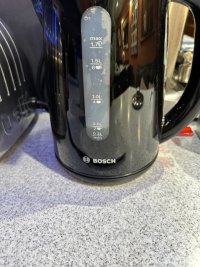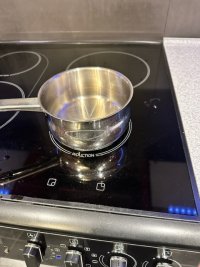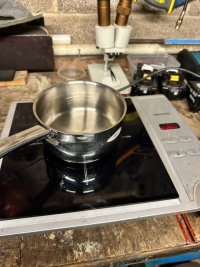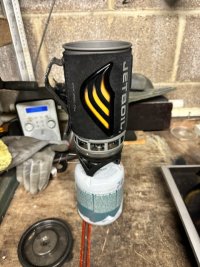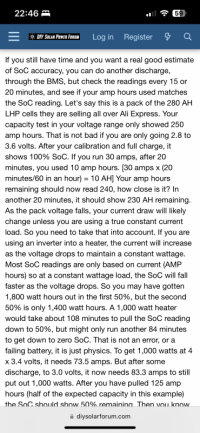You are using an out of date browser. It may not display this or other websites correctly.
You should upgrade or use an alternative browser.
You should upgrade or use an alternative browser.
Induction hob power draw question
- Thread starter Epic-Rob
- Start date
So if you upped (assumed) the induction to 2600w and guesstimated its probably similar to kettle.All tests using 500ml water (2 cups according to my kettle)
Mains Kettle drawing 2600w (according to my meter) 1:18
small pan on small induction zone drawing 1100w 3:37
small pan on portable induction stove 1800w 2:04
small jetboil flash 3:31
View attachment 184710View attachment 184709View attachment 184711View attachment 184712
Great. Process of elimination.shunt is directly next to the battery and was originally set up with help of loz amd Dell, so pretty confident the shunt readings are all good
I just put the kettle on 10 minutes before I want a brew and do something else.considered that option but its the time it takes to heat up - want a brew in 2 mins not 10.
What doesn’t make sense here is that the % remaining on the battery as reported by the shunt doesn’t match the observed current (which is exactly what you’re saying). Could it be something to do with the voltage being variable over the discharge while boiling or as the battery gets further depleted? Might that explain your observation that it draws more as your stay gets longer?
Thats what doesn't make sense to me either, but i have no way to double check what the Ah is in the battery other than what the shunt tells me.What doesn’t make sense here is that the % remaining on the battery as reported by the shunt doesn’t match the observed current (which is exactly what you’re saying). Could it be something to do with the voltage being variable over the discharge while boiling or as the battery gets further depleted? Might that explain your observation that it draws more as your stay gets longer?
Probably:-
As you draw current the battery voltage will drop. More so as you draw at or above the rated discharge current. As the voltage drops the inverter will compensate by drawing more current to maintain its own power output. (ohms law)
The Ah capacity of the battery is regardless of the voltage.
As you draw current the battery voltage will drop. More so as you draw at or above the rated discharge current. As the voltage drops the inverter will compensate by drawing more current to maintain its own power output. (ohms law)
The Ah capacity of the battery is regardless of the voltage.
Ah!
Just read CJWs post - essentially what I thought!
Just read CJWs post - essentially what I thought!
Can’t believe jetboil is no quickeryes but i am trying to get away from all the gas thing - i am sure it is nearly as quick to boil but by the time you have got it out of cupboard set it up etc i may as well just use a built in gas hob!
Maybe not quicker but return on investment is a couple of days instead of years.Can’t believe jetboil is no quicker
In my case, I have a 180amp Lithium LifePo4 and a 1800watt inverter fitted. We use an portable induction hob all the time whilst away, and it works a treat. Evening meals take about 20/40 minutes and whilst the hob can draw in full power a lot of amps, we never use it on more than setting 3 ( Boil water around 170/180amps ) and on settings 1 30/40 amps. To date, we have never seen the battery go below 40% after cooking a meal. If battery in 100% full, it drops to around 75%/60% Then we plug in coffee maker and it takes another 10% for 2/3 coffees. The next day (here in Spain) depending on time of year it's full again by 4pm or we drive to new location and B2B does the job.
We have not used the gas cooker for months now (it is ready just in case). We also have my old Army jet boil (10 years old now) but find induction does it quicker.
Next time we are out in the camper, I will do some tests and take photo's
We have not used the gas cooker for months now (it is ready just in case). We also have my old Army jet boil (10 years old now) but find induction does it quicker.
Next time we are out in the camper, I will do some tests and take photo's
Last edited:
PB-T6
Member
electric kettle v Hob
ok test done.
1Lwater in electric kettle took 4minutes 15 sec to boil, it drew 171amps continuously.
the ‘battery computer ‘showed it used 19amp/ hr from battery.
1L water in hob kettle, I switched it on and adjusted the power such that it also drew a peak of 171 amps (showed 1800W setting) . It took 8 min. 15 sec , and showed in total 25amps/hr taken.
clearly the power used dropped away as the hob cycled on and off.
also noted the interior LED lights flicker when induction running.
I have now ordered a suitable size electric kettle and sent the hob kettle back from whence it came.
ok test done.
1Lwater in electric kettle took 4minutes 15 sec to boil, it drew 171amps continuously.
the ‘battery computer ‘showed it used 19amp/ hr from battery.
1L water in hob kettle, I switched it on and adjusted the power such that it also drew a peak of 171 amps (showed 1800W setting) . It took 8 min. 15 sec , and showed in total 25amps/hr taken.
clearly the power used dropped away as the hob cycled on and off.
also noted the interior LED lights flicker when induction running.
I have now ordered a suitable size electric kettle and sent the hob kettle back from whence it came.
i think when you have seen 50k plus disapear down a VW transporter hole a few hundred quid investment in an induction hob it peanuts ;-)Maybe not quicker but return on investment is a couple of days instead of years.
What size solar panel you got?In my case, I have a 180amp Lithium LifePo4 and a 1800watt inverter fitted. We use an portable induction hob all the time whilst away, and it works a treat. Evening meals take about 20/40 minutes and whilst the hob can draw in full power a lot of amps, we never use it on more than setting 3 ( Boil water around 170/180amps ) and on settings 1 30/40 amps. To date, we have never seen the battery go below 40% after cooking a meal. If battery in 100% full, it drops to around 75%/60% Then we plug in coffee maker and it takes another 10% for 2/3 coffees. The next day (here in Spain) depending on time of year it's full again by 4pm or we drive to new location and B2B does the job.
We have not used the gas cooker for months now (it is ready just in case). We also have my old Army jet boil (10 years old now) but find induction does it quicker.
Next time we are out in the camper, I will do some tests and take photo's
I think the lithium bank is the real cost. I get by with 110Ah of AGM with no issues.i think when you have seen 50k plus disapear down a VW transporter hole a few hundred quid investment in an induction hob it peanuts ;-)
I agree with @DXX on the virtues of the Wallas duo.i think when you have seen 50k plus disapear down a VW transporter hole a few hundred quid investment in an induction hob it peanuts ;-)
I have one and it's awesome, but also have a small electric kettle for the quick brew. Kettle was £20 and the Wallas was compatible money to a diesel heater and hob.
Nominal electrical draw, limited condensation from no naked flame, no need to store a gas bottle, safety from no gas, all add up to the Wallas and small electric kettle being a great option.
(I have a single induction hob that I carry on my caravan; to save gas on our travels, but concern over battery capacity rules out induction cooking for me unless on EHU.)
I have 200 watts panel on the roof and 100 watt portable. On a good day here in Spain I can get 10/15amps in spring/summer/autumn 8am to 9pm, in winter 6/10amps 10am to 4pmWhat size solar panel you got?
Similar threads
- Replies
- 16
- Views
- 838
- Replies
- 19
- Views
- 2K
- Replies
- 6
- Views
- 338
- Replies
- 12
- Views
- 998

